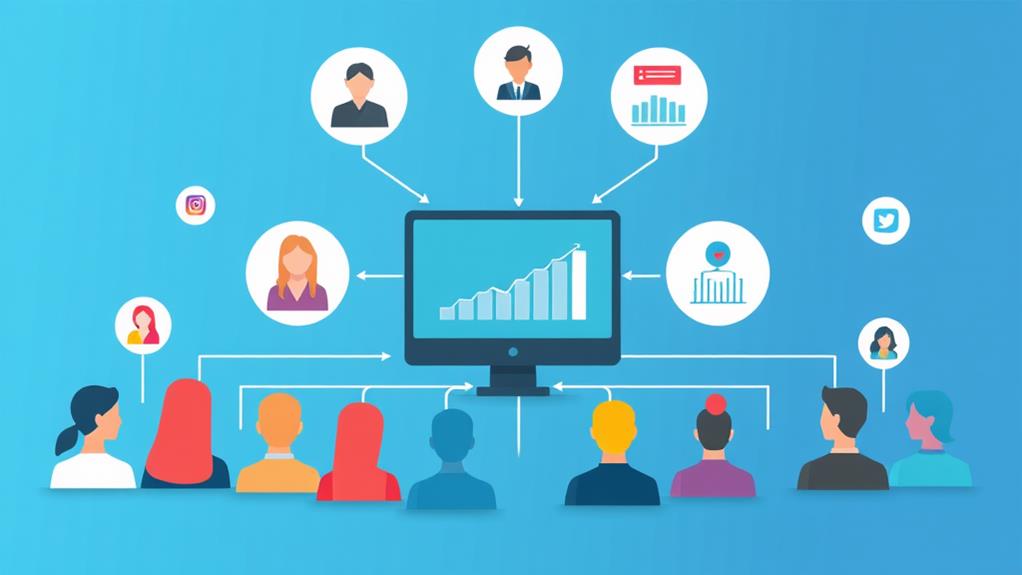Small businesses should leverage social media automation tools to streamline operations and boost brand visibility, potentially increasing reach by up to 60%. Vital practices include selecting user-friendly tools with strong integration capabilities like Hootsuite and Buffer, fundamental for cost-effective scalability. Setting SMART goals aligned with key metrics such as engagement rates and website traffic is imperative. Utilize content calendars and scheduling features to maintain consistency and optimize posting times, enhancing follower interaction by up to 30%. Advanced analytics and chatbots further refine strategies and improve customer engagement. Effective use of these best practices can considerably enhance your social media strategy.
Key Takeaways
- Choose user-friendly, budget-friendly tools with robust analytics and integration capabilities to enhance workflow efficiency.
- Set SMART goals to align social media efforts with business objectives and regularly review performance metrics for timely adjustments.
- Develop a content calendar for balanced and high-quality content, leveraging automation tools for optimized posting times.
- Conduct thorough demographic analysis and use social media analytics to identify and understand your target audience.
- Utilize storytelling techniques and user-generated content to enhance engagement and maintain audience interest.
Importance of Social Media Automation
In today's digital landscape, the importance of social media automation cannot be overstated, particularly for small businesses aiming to maximize their online presence with limited resources.
Social media automation tools streamline the management of multiple platforms, enabling businesses to maintain a consistent presence without the burden of manual effort. This consistency is vital, as social media trends indicate that brand visibility can increase by up to 60% with regular posting. Leveraging automation tools like Iconosquare for Social Media Management, businesses can access advanced analytics and generate custom reports to keep stakeholders informed.
Automating repetitive tasks such as scheduling posts and responding to common inquiries not only saves time but also enhances operational efficiency. This allows businesses to allocate more resources to strategic activities that necessitate human creativity and engagement, aligning with audience behavior that favors timely and relevant interactions.
Moreover, automation tools offer valuable analytics and performance insights. These data-driven metrics empower small businesses to refine their social media strategies based on real-time audience engagement, ensuring content aligns with current social media trends.
The professional appearance and improved customer interaction facilitated by automation are significant, as 70% of consumers expect prompt responses from brands. Therefore, implementing social media automation is an essential strategy for small businesses to boost their digital presence and meet audience expectations effectively.
Choosing the Right Tools
When selecting social media automation tools, it is vital to compare key features such as user-friendliness, integration capabilities, and cost-effectiveness to guarantee they align with your business needs.
Small businesses should prioritize options that offer seamless integration with existing platforms and budget-friendly subscription models to optimize resource allocation.
Additionally, robust analytics and reporting functionalities are essential for making data-driven decisions that enhance engagement and overall social media strategy.
Tools like Hootsuite offer advanced scheduling and detailed performance metrics, making them ideal for maintaining consistent audience interaction and refining content strategies.
Key Features Comparison
Selecting the right social media automation tool is frequently pivotal for enhancing your digital marketing strategy. Conducting a thorough feature comparison can streamline this process, ensuring you select a tool that aligns with your business needs.
User-friendliness is a critical factor; tools like Buffer and Hootsuite are renowned for their intuitive interfaces, making them ideal for users with varying levels of expertise. Tool evaluation should also consider integration capabilities; for instance, Sprout Social's seamless integration with CRM systems can greatly enhance workflow efficiency.
Analytics and reporting features are indispensable for tracking performance and informing strategic adjustments. Sendible excels in this area, offering extensive analytics and performance reports.
Furthermore, evaluating the cost-effectiveness of tools is essential. SocialPilot provides affordable plans that support bulk scheduling, making it a budget-friendly option for small businesses.
Budget-Friendly Options
While cost-efficiency remains a top priority for small businesses, selecting the right social media automation tools requires a strategic approach to maximize value. Affordable tools like Buffer and SocialPilot offer competitive pricing plans that include essential features without breaking the bank. In addition, many platforms provide trial periods, enabling small businesses to test functionality before committing to a subscription.
Opting for tools with flexible pricing models, such as Hootsuite and Sendible, allows businesses to select plans that fit their current budget and scale up as their social media needs evolve. Moreover, evaluating tools that offer bulk scheduling, like Agorapulse, can save time and resources by managing multiple posts across various platforms efficiently.
Customer support and learning resources are also vital. Tools with robust support systems and thorough tutorials help businesses maximize their investment and enhance their social media strategy.
| Tool | Key Feature |
|---|---|
| Buffer | Competitive Pricing |
| SocialPilot | Essential Features |
| Hootsuite | Tiered Pricing Models |
| Agorapulse | Bulk Scheduling |
Ease of Integration
Prioritizing ease of integration, businesses should focus on selecting social media automation tools that seamlessly connect with their existing digital ecosystems, including CRM systems, e-commerce platforms, and analytics software.
Addressing integration challenges is essential for small businesses aiming to streamline workflows and enhance data sharing. Tools that support multiple social media networks enable centralized management and consistent messaging, making them invaluable for resource-constrained enterprises.
The automation benefits extend further when tools are compatible with third-party apps and services. This compatibility can greatly improve functionality by linking email marketing tools or customer support systems, resulting in a more cohesive digital strategy.
Additionally, the learning curve associated with each tool should be considered; opting for user-friendly interfaces can simplify integration processes and reduce adaptation time for team members.
API support availability is another pivotal factor, providing greater flexibility for custom integrations tailored to specific business needs and operational requirements.
API capabilities can bridge gaps between disparate systems, ensuring that automation tools work harmoniously within the broader digital ecosystem.
Setting Clear Goals

Defining clear objectives is essential for the successful implementation of social media automation tools. Establishing SMART goals—Specific, Measurable, Achievable, Relevant, and Time-bound—provides a solid framework for small businesses to align their social media efforts with broader business objectives.
Goal alignment guarantees that automation tools contribute effectively to overall marketing strategies, fostering a cohesive online presence.
To assess the effectiveness of social media automation, businesses should set measurable metrics such as engagement rates or website traffic. These metrics offer valuable insights into performance reviews, enabling timely adjustments and optimizations.
For instance, tracking engagement rates can help determine if the content resonates with the target audience, while monitoring website traffic can show if social media efforts are driving desired actions. Regularly reviewing metrics like conversion rates can also aid in understanding the effectiveness of specific campaigns and refining strategies accordingly.
Regularly reviewing and updating goals based on performance data is vital for maintaining agility. This practice allows small businesses to respond to changing market dynamics and audience preferences swiftly.
Clear goals, such as increasing brand awareness by a specific percentage within a set timeframe, provide direction for content creation and automation efforts, motivating the team and guaranteeing a focused approach.
Crafting Your Strategy
Having established clear objectives, the next step involves crafting a robust social media strategy to effectively utilize automation tools. Begin by setting SMART goals to guarantee your efforts are Specific, Measurable, Achievable, Relevant, and Time-bound. For instance, you might aim to increase brand awareness by 20% over the next quarter through consistent posting and engagement.
Regularly reviewing analytics is essential for informed decision-making, as it provides insights into what content performs best and when your audience is most active.
To align your strategy with your content audience's needs, develop a content calendar. This planning tool guarantees a balanced mix of promotional, educational, and entertaining content, tailored to resonate with your target audience.
Leverage social media management tools to automate posting times based on audience activity data. This optimization guarantees your posts reach the maximum number of users when they are most active, thereby enhancing engagement rates and overall reach.
Regularly review your strategy alignment using performance analytics. Key metrics such as engagement rates and follower growth provide vital insights that help refine your approach.
Identifying Your Audience

Identifying your audience is a significant component in the successful deployment of social media automation tools. To achieve this, start by conducting a thorough demographic analysis, examining factors such as age, gender, location, and interests. This information is vital for creating accurate audience personas, which allow for more tailored and effective content strategies.
Utilize social media analytics tools to uncover valuable audience insights. By examining engagement trends, such as peak interaction times and preferred content types, you can optimize your posting schedule and enhance engagement rates.
Surveys and polls serve as effective feedback loops, providing direct input from your audience on their content preferences and needs. Additionally, monitoring key engagement metrics, like likes, comments, and shares, can further refine your understanding of audience behavior and content resonance.
Behavior segmentation is another key strategy, enabling you to categorize your audience based on their interactions with your brand. This segmentation allows for personalized marketing efforts, increasing the relevance and impact of your campaigns.
Trend monitoring is essential to stay abreast of changing consumer behaviors and preferences. Regularly updating and revisiting your audience profiles guarantees that your messaging remains current and resonant.
Content Creation Tips
To maximize the impact of your social media automation tools, focus on producing high-quality content that resonates with your audience.
Employ storytelling techniques to create emotionally engaging narratives, which can boost customer engagement by up to 30%.
Additionally, integrating user-generated content into your strategy not only showcases authentic customer experiences but also enhances engagement and trust within your community.
Diversifying content types, such as images, videos, and carousels, keeps your feed fresh and engaging.
Incorporating user-generated content can lead to a 28% higher engagement rate, amplifying your reach and authenticity.
Prioritize Quality Over Quantity
In the dynamic landscape of social media, prioritizing quality over quantity is vital for effective content creation. High-quality, visually appealing content aligns with your brand identity and greatly boosts engagement, with posts featuring compelling images receiving 94% more views than text-only posts. Consistency in tone and style is also essential, as it reinforces brand recognition and can increase revenue by up to 23%.
To enhance content curation, small businesses should leverage user-generated content (UGC), which showcases authenticity and fosters community engagement. 79% of consumers report that UGC highly impacts their purchasing decisions. Analyzing audience feedback and engagement metrics is necessary to identify what resonates most with your audience, allowing for the refinement of content strategies.
| Key Aspect | Benefit | Data Insight |
|---|---|---|
| High-Quality Visuals | Increased Engagement | 94% more views than text-only posts |
| Consistent Branding | Revenue Growth | Increases revenue by up to 23% |
| User-Generated Content | Authenticity & Engagement | 79% of consumers influenced in purchasing |
| Audience Feedback | Strategy Refinement | Identifies resonating content for better curation |
Leverage Storytelling Techniques
Leveraging storytelling techniques in your social media strategy can greatly strengthen audience engagement and brand loyalty. By incorporating relatable narratives, such as customer success stories or testimonials, you can markedly enhance the connection between your brand and its audience.
Employing the "Problem-Agitate-Solution" framework effectively highlights customer pain points, evokes emotions, and demonstrates how your product or service provides a solution. This method not only captivates but also retains audience interest.
To maintain consistent audience engagement, create a content calendar that aligns storytelling themes with holidays or relevant events. This approach keeps your brand top of mind and guarantees timely and trend-aware content dissemination.
Additionally, utilizing visuals like images or videos alongside your stories can create a more immersive experience, capturing attention and increasing shareability on social media platforms.
Encouraging audience participation by inviting them to share their own stories related to your brand fosters a sense of community and enhances user-generated content. This participatory culture further solidifies customer narratives as a pivotal aspect of your social media strategy.
- Share customer success stories or testimonials
- Use the "Problem-Agitate-Solution" framework
- Align content with holidays or relevant events
- Incorporate visuals for immersive storytelling
Scheduling Posts Efficiently

Efficient scheduling of social media posts is vital for maintaining a consistent brand presence and maximizing audience engagement. Utilizing tools like Buffer and Hootsuite allows small businesses to plan and automate posts across multiple platforms, guaranteeing consistency without manual intervention. Analyzing analytics to determine ideal post timing is essential, as studies show that posts made during peak engagement times can boost interaction by up to 30%. Audience segmentation further refines this approach, tailoring content to specific groups.
Creating a content calendar helps organize and visually plan posts in advance, balancing promotional and engaging content while reducing last-minute stress. Experimenting with different posting frequencies and times is recommended; data suggests brands posting 1-2 times daily on platforms like Instagram experience higher engagement rates. Regular review and adjustment of scheduling strategies based on performance metrics guarantee continuous improvement and alignment with audience preferences.
| Strategy | Benefit |
|---|---|
| Utilize scheduling tools | Consistent brand messaging |
| Analyze peak engagement times | Increased visibility and interaction |
| Create a content calendar | Balanced content mix, reduced stress |
| Experiment with posting frequency | Improved engagement rates |
| Regular strategy review | Refined approach, better results |
Monitoring Engagement
Tracking engagement metrics such as likes, shares, comments, and click-through rates is essential for evaluating the effectiveness of your social media strategy. Regularly monitoring these metrics allows small businesses to understand engagement trends and audience behavior, helping to tailor content to maximize impact.
Utilize analytics tools integrated within your social media automation platforms to gather valuable insights into content performance and identify which types of posts resonate most with your audience. Tools like Phlanx and HypeAuditor can be particularly useful for understanding audience interaction and engagement quality.
Here are key practices for monitoring engagement:
- Automated Reports: Set up weekly or monthly summaries to track engagement benchmarks and adjust your strategy accordingly.
- Social Listening: Implement tools to monitor brand mentions and conduct sentiment analysis, gaining valuable demographic insights and understanding audience perceptions.
- Timely Responses: Develop response strategies to engage with your audience promptly, maintaining a balance between automated interactions and personal touch.
- Interaction Frequency: Analyze the frequency and timing of engagement to optimize posting schedules and maximize reach.
Analyzing Performance Data

Analyzing performance data is vital for optimizing your social media strategy, as it allows you to track key engagement metrics like reach, conversion rates, and audience behavior.
By utilizing A/B testing and automated reporting features, you can identify which types of content and posting times generate the highest engagement, enabling data-driven adjustments to your strategy.
TikTok Analytics, for example, provide essential insights into engagement trends, helping you understand what resonates with your audience.
Additionally, monitoring audience demographics and leveraging social listening tools provide deeper insights into your target market, helping to refine content and boost overall engagement and loyalty.
Tracking Engagement Metrics
Regularly monitoring key performance indicators (KPIs) such as engagement rate, reach, and conversion rates is vital to assess the effectiveness of social media automation efforts.
Utilizing analytics tools like Buffer or Sprout Social can help generate detailed reports that highlight audience interaction patterns and content performance over time. By segmenting engagement metrics by post type—whether it's an image, video, or link—businesses can pinpoint which formats resonate most with their audience, thereby enabling more informed content decisions.
Setting specific engagement benchmarks grounded in historical performance data is essential for measuring progress and adapting strategies to evolving audience behaviors and preferences.
Analyzing peak engagement times through automated reports also allows businesses to schedule posts when their audience is most active, thereby maximizing visibility and interaction rates.
Key steps to track engagement metrics effectively:
- Utilize analytics tools: Platforms like Buffer or Sprout Social for detailed performance reports.
- Segment engagement metrics: By post type to identify high-performing content formats.
- Set specific benchmarks: Based on historical data to measure progress.
- Analyze peak engagement times: Schedule posts for best visibility and interaction.
Employing these practices guarantees a data-driven approach that aligns with current trends and audience preferences, ultimately enhancing the impact of social media automation.
Optimizing Content Strategies
How can businesses guarantee their social media content is consistently engaging and effective? The answer lies in thoroughly analyzing performance data to optimize content strategies. Regularly monitoring metrics such as engagement rates, reach, and conversion rates helps identify which content trends resonate most with your audience. Adjusting your strategy based on these insights guarantees alignment with audience preferences, thereby enhancing overall effectiveness.
Utilizing A/B testing within social media automation tools is essential. By comparing different content formats, posting times, and messaging styles, businesses can determine the most effective combinations for their specific audience. This approach enables data-driven decisions, fostering improved engagement and reach.
Leveraging analytics features available on social media platforms allows for a deeper understanding of audience demographics and behavior. This data is invaluable for creating targeted content that aligns with followers' interests, enhancing relevancy and engagement.
Setting specific, measurable KPIs based on historical performance data guarantees that content goals are aligned with overall marketing objectives. Regularly reviewing performance reports and incorporating these insights into future content planning establishes a feedback loop that fosters continuous improvement.
Engaging With Followers
Efficiently engaging with followers on social media is pivotal for any brand looking to foster a loyal community and enhance customer satisfaction.
Active monitoring of social media interactions using automation tools is essential. Responding swiftly to comments and messages can increase customer satisfaction by up to 70%.
Implementing social listening features allows small businesses to track brand mentions and audience sentiments, providing a robust feedback loop for addressing concerns and engaging in relevant conversations.
Encouraging user-generated content through campaigns that invite followers to share their experiences can lead to a 28% increase in engagement rates.
Regularly analyzing engagement metrics through automation tools helps refine content strategies, ensuring that interactions are meaningful and resonate with your audience.
Additionally, engaging with comments demonstrates value for user input, which can further enhance community relationships.
Key strategies include:
- Social Media Monitoring: Use automation tools to monitor and swiftly respond to interactions, enhancing community building.
- Social Listening: Track brand mentions and audience sentiments to engage in relevant discussions and address concerns timely.
- User-Generated Content: Create campaigns inviting followers to share their experiences, boosting engagement rates.
- Engagement Metrics Analysis: Regularly analyze metrics to refine strategies and understand what content resonates most with your audience.
Using Chatbots Effectively

Effectively leveraging chatbots can revolutionize customer service operations by handling up to 80% of routine inquiries, guaranteeing immediate, round-the-clock responses that greatly enhance customer satisfaction. By implementing AI-driven chatbots, small businesses can offer personalized interactions, aligning with the trend that 70% of consumers prefer using chatbots for quick answers over waiting for human support.
This approach not only boosts customer satisfaction but also markedly reduces operational costs by up to 30%, as it automates repetitive tasks and allows human agents to focus on more complex issues. Additionally, using data-driven insights to tailor chatbot responses according to audience preferences can further enhance engagement and effectiveness.
To maximize efficiency, chatbots should be programmed to recognize keywords and context, enabling them to provide responses tailored to customer intent. This level of chatbot personalization can immensely improve user experience, making interactions feel more relevant and engaging.
Regular monitoring and updating of chatbot responses based on customer feedback are essential. This practice guarantees that the automated responses remain effective and relevant, which can lead to a notable 20-40% increase in customer retention rates.
Creating Impactful Ads
Creating impactful ads requires a strategic blend of engaging visual elements and clear messaging techniques, essential for capturing audience attention and driving engagement.
Incorporating A/B testing strategies allows marketers to identify the most effective ad components, resulting in optimized click-through rates and conversion outcomes.
Engaging Visual Elements
In the competitive landscape of social media marketing, integrating engaging visual elements into your ads is paramount for capturing audience attention and driving results. High-quality visuals play a critical role, with posts featuring images receiving 94% more views than those without.
Utilizing visual storytelling and graphic design can greatly enhance the impact of your ads.
Key strategies include:
- High-Quality Visuals: Leveraging professional graphic design guarantees your visuals are fascinating and polished, which is essential since posts with images have a 94% higher view rate.
- Video Content: Video ads are highly engaging, with studies indicating they can boost purchase intent by up to 97% and brand association by 139%.
- Infographics: These are particularly effective for information retention, as people remember 65% of the information presented visually after three days, compared to just 10% when presented in text.
- Consistent Branding: Incorporating consistent branding elements such as color schemes and logos enhances brand recognition by 80%, reinforcing your brand identity across all ads.
Adopting these data-driven techniques guarantees your visual elements are not only eye-catching but also strategically positioned to maximize engagement and conversion rates.
This keeps your brand ahead of the curve in the ever-evolving social media landscape.
Clear Messaging Techniques
Building upon the significance of engaging visual elements, it is equally important to master clear messaging techniques to create impactful ads. Utilizing concise language in your ad copy is essential; studies indicate that ads with shorter texts see higher engagement and conversion rates. To enhance message clarity, guarantee the text is compelling and straight to the point, quickly grabbing attention.
Incorporating strong call-to-action (CTA) phrases like "Limited Time Offer" or "Shop Now" is another effective strategy. These CTAs can boost click-through rates by up to 30%, creating a sense of urgency that drives immediate action. Moreover, consistency in messaging across all social media platforms is crucial for reinforcing brand recognition, with 64% of consumers valuing shared principles.
Here's a breakdown of key techniques:
| Technique | Impact |
|---|---|
| Concise Language | Higher engagement and conversion rates |
| Strong Call-to-Actions | Increase click-through rates by up to 30% |
| Consistent Messaging | Reinforces brand recognition (64% value) |
A/B Testing Strategies
Implementing A/B testing strategies is paramount for crafting ads that truly resonate with your audience. A/B testing involves creating two versions of an ad (Version A and Version B) with a single variable changed to determine which version performs better regarding engagement and conversion rates.
To guarantee your A/B tests yield meaningful insights, follow these best practices:
- Sample Size: Aim for at least 1,000 impressions per ad variant to achieve statistical validity.
- Real-Time Testing: Conduct tests on the same platform and under similar conditions to maintain platform consistency and eliminate external variables.
- Performance Indicators: Track key performance indicators (KPIs) such as click-through rates (CTR), conversion rates, and engagement levels to identify the most effective ad variations.
- Continuous Optimization: After identifying a winning ad, iteratively test new variations to continuously optimize ad performance.
Adherence to these strategies guarantees that your A/B testing is both rigorous and reliable. By controlling variables and analyzing engagement data in real-time, small businesses can make data-driven decisions that enhance ad impact.
Continuous optimization based on performance indicators keeps your campaigns dynamic and aligned with audience preferences, ultimately driving higher engagement and conversions.
Integrating Organic and Paid Efforts

Maximizing your social media strategy requires a seamless integration of organic and paid efforts, a synergy that can greatly extend your content's reach.
Integrating content amplification strategies involves promoting high-performing organic posts through paid ads, enhancing visibility and engagement. Studies indicate that businesses can increase engagement by up to 50% by leveraging this approach.
Audience segmentation techniques play an essential role; identifying and targeting specific demographics guarantees that your content reaches the most relevant users.
A/B testing is pivotal in determining which organic posts should be amplified. By experimenting with different posts, you can allocate your budget towards those that resonate most with your audience.
Retargeting ads further enhance this strategy by re-engaging users who have previously interacted with your organic content, resulting in conversion rates that are typically 10 times higher than standard ads.
Maintaining consistent branding across both paid and organic efforts is vital. Verify that visuals, messaging, and tone are aligned to foster brand recognition and trust.
Monitoring performance metrics using analytics tools allows for data-driven adjustments, optimizing the synergy between organic and paid content. This integrated approach can markedly improve the overall effectiveness of your social media campaigns.
Scaling Your Efforts
Expanding upon the synergy between organic and paid efforts, the next logical step involves scaling your social media initiatives to enhance overall impact. To effectively scale, it is essential to regularly evaluate your current impact by analyzing user engagement metrics. Identifying successful strategies and areas for improvement guarantees continuous growth.
Implementing automation tools like Buffer or Hootsuite can streamline repetitive tasks. This not only frees up your team to focus on strategic initiatives but also maximizes efficiency.
Leveraging audience insights gathered from analytics tools allows for refined audience segmentation. Customizing your content and advertisements based on these insights can notably boost engagement and reach.
Utilize A/B testing to experiment with different content types, posting times, and advertising strategies. This data-driven approach enables informed decision-making, fundamental for scaling efforts effectively.
As your social media presence grows, consider outsourcing certain tasks or investing in advanced tools to manage the increased volume and complexity.
- Analyze Engagement Metrics: Regularly assess user engagement to identify successful strategies.
- Use Automation Tools: Implement tools like Buffer or Hootsuite to streamline tasks.
- Leverage Audience Insights: Customize content and ads using audience segmentation.
- A/B Testing: Experiment with different strategies for data-driven scaling.
Frequently Asked Questions
How to Automate Your Business Social Media?
To automate your business's social media, employ content scheduling tools for consistent posting and use analytics to refine strategies. Enhance audience engagement by integrating chatbots and curating relevant content, ensuring an effective and efficient social media presence.
What Are the 5 Best Practices for a Social Media Marketer?
The five best practices for a social media marketer include defining clear objectives, utilizing a content calendar, implementing content curation strategies, balancing automation with engagement strategies, and regularly analyzing performance metrics to remain trend-aware and data-driven.
How Can Small Businesses Use Social Media Effectively?
Small businesses can use social media effectively by developing a robust content strategy and prioritizing audience engagement. This approach guarantees targeted, high-quality posts that foster community interaction, driving brand loyalty and optimizing reach.
What Should Be the Best Practices While Using Social Media?
Develop a robust engagement strategy by utilizing a content calendar for consistent posting, diversifying content types, leveraging analytics for performance tracking, and balancing automation with real-time interactions to cater to audience preferences effectively.
Conclusion
Incorporating social media automation tools into small business strategies can notably enhance efficiency and engagement. Selecting appropriate tools, setting clear objectives, and understanding the target audience are vital steps. Effectively utilizing chatbots and crafting impactful advertisements further optimize outcomes. Integrating organic and paid efforts allows for scalable growth, enabling businesses to maximize their social media presence. Adhering to these best practices guarantees that small enterprises can navigate the digital landscape with a data-driven, informed approach.




